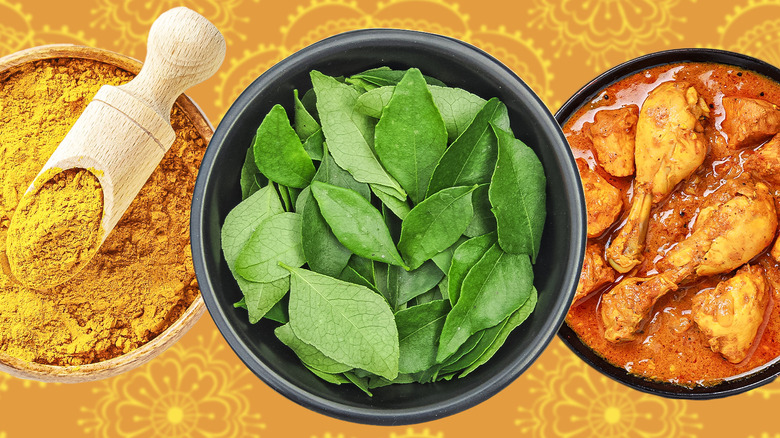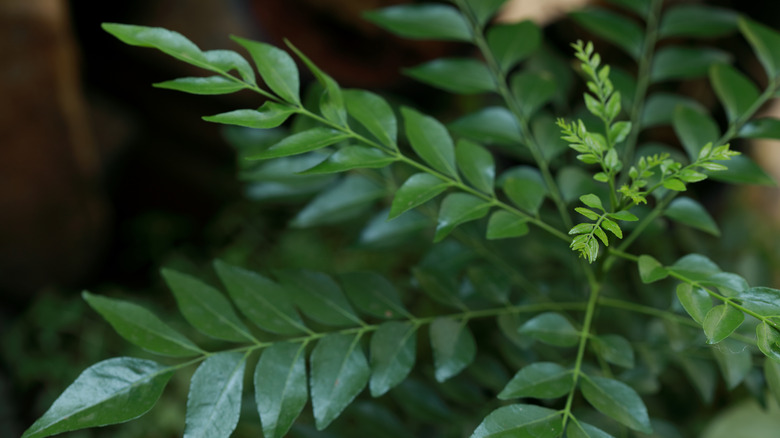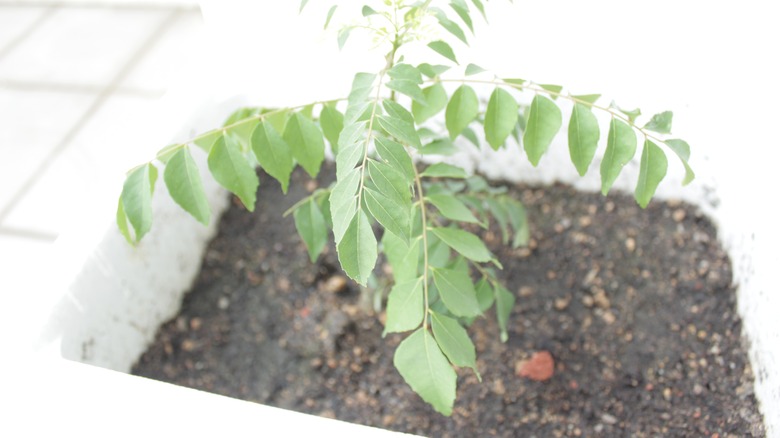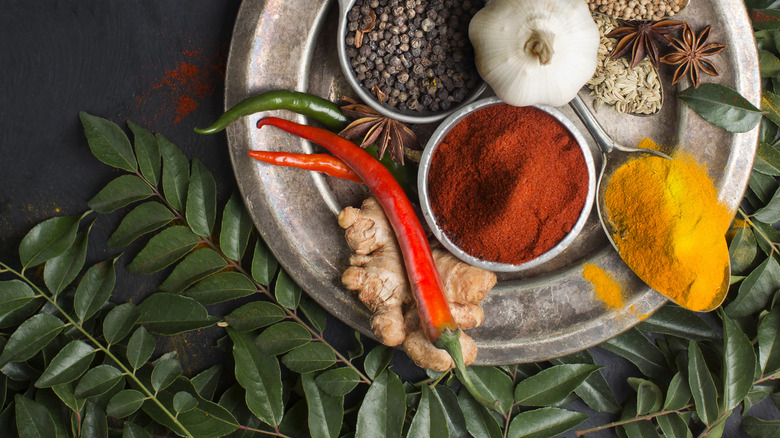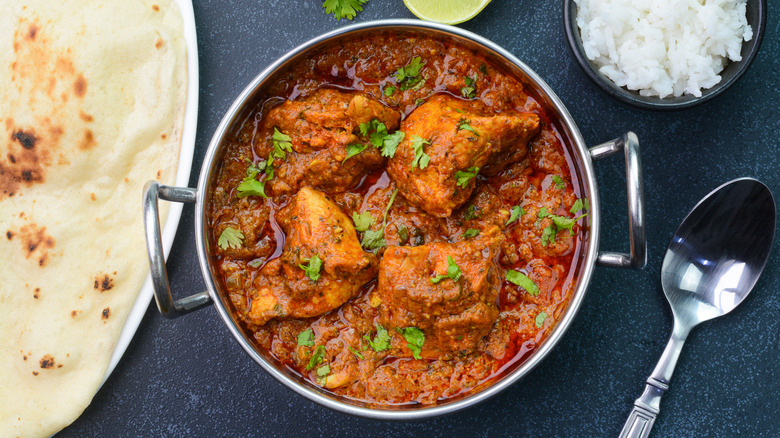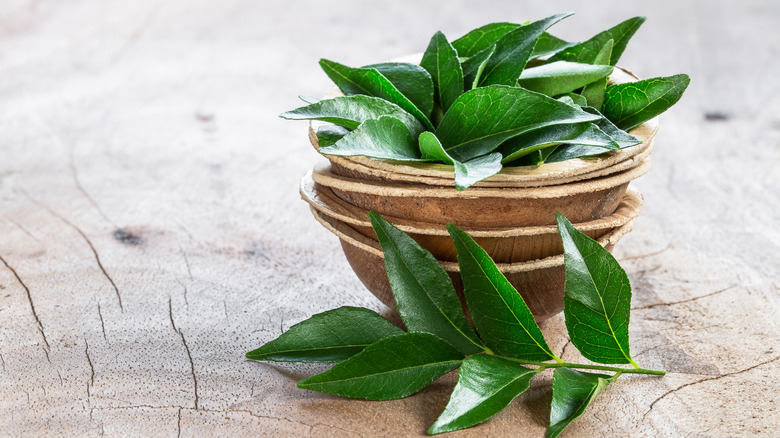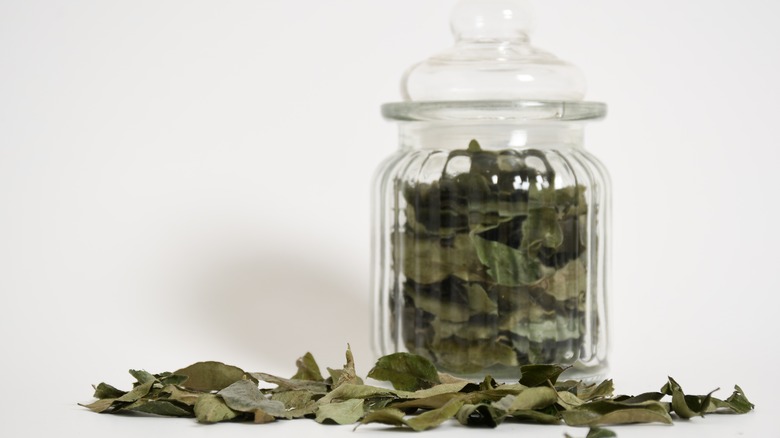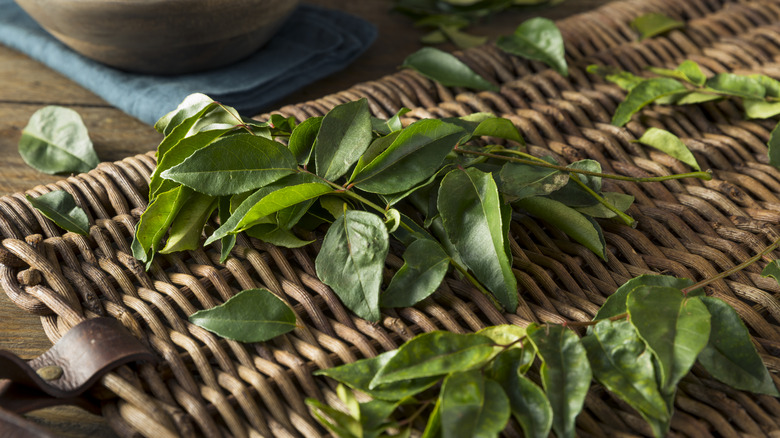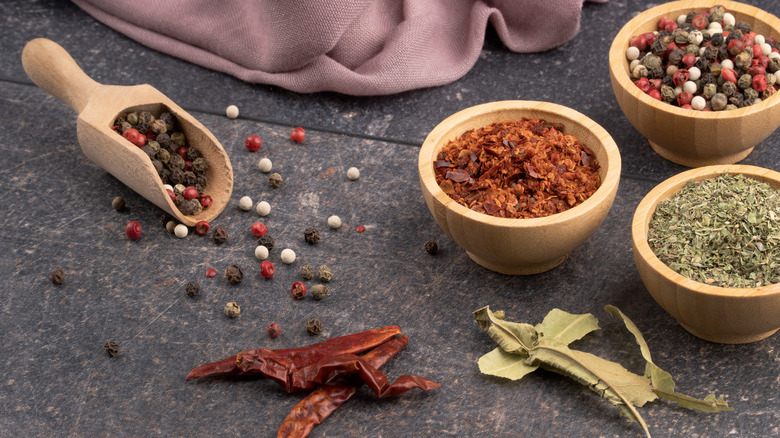Curry Leaves Are The Underrated Aromatic Spice You Need To Try
When it comes to Indian and South Asian cooking, there's one ingredient that's somewhat of a must-have: curry leaves. Though they may look small and delicate, curry leaves pack a powerful punch and are an essential part of providing tasty and vibrant foundations to an array of dishes. Indeed, unlike some herbs, curry leaves do not simply serve as a garnish or final flourish, but rather are crucial for adding depth and warmth to everything from curries and stews to chutneys and side dishes.
However, despite their widespread and long-standing use in South Asian cuisine, many people outside of these regions, or those unfamiliar with the culinary culture and common ingredients, are unaware of the potential of curry leaves. Their distinct aroma and unique taste, which boasts a nuanced balance of citrus, pepperiness, and light bitterness, lends an authentic and inimitable flavor to whatever they are cooked with, elevating the aroma and richness of entire dishes significantly. If you've never cooked with curry leaves before, incorporating them into your prep can unlock a whole new dimension of flavor, but you need to know how to use them properly. For expert input on these glossy, tasty powerhouses, we reached out to Nandita Godbole, cookbook author and Indian cuisine expert, who emphasizes the importance, versatility, and possibilities of fresh curry leaves in traditional cooking. Godbole's know-how provides useful insight into this humble yet powerful ingredient, from how to incorporate them into your cooking to how to ensure maximum freshness for maximum flavor.
What are curry leaves?
Curry leaves are a staple ingredient in Indian and many South Asian cuisines, known for their unique and aromatic properties that can be used to impart distinctive flavor and depth to heighten a variety of dishes. Not to be mistaken for curry powder, which is a blend of various ground spices and herbs, curry leaves are commonly used whole or chopped, in a similar way to bay leaves. If you've never tried curry leaves before (although if you've ever eaten at an authentic Indian restaurant, you most likely have), you might be somewhat surprised by their flavor, especially if you're expecting them to taste like curry. Instead, they offer a fragrant, earthy profile with subtle citrusy and herbaceous notes which make them a key ingredient for providing nuance and richness to an array of foods.
As Nandita Godbole tells us, curry leaves come from the subtropical and tropical Murraya koenigii plant, originating from the humid forests of India and Sri Lanka. The plant produces long leaves which are adorned with small, delicate, and glossy leaflets. The leaflets range in amount and size, but typically measure around 1-2 inches long and up to 21 leaflets can be harvested from one pinnate leaf. Murraya koenigii is related to citrus, as Godbole notes, "and much like citrus leaves, the leaves carry sweet essential oils that impart it an unmistakable aroma." In other words, much of the extraction of the fragrant qualities of curry leaves comes through releasing these oils.
How are curry leaves grown?
The Murraya koenigii plant thrives in tropical and subtropical climates, where Nandita Godbole notes that it can grow to be a small tree, with heights ranging between 6 and 15 feet in optimal conditions. "The plant needs lots of fresh air, plenty of sunshine, and must be regularly watered," she says, which makes them ideal for outdoor gardening in warm and sunny regions. Indeed, there's no doubt that curry leaves are best cultivated outside in hot and moist conditions, akin to those in which the plant is found naturally. However, there remains a possibility of growing and harvesting curry leaves in cooler climates, too.
As Godbole confirms, a greenhouse offers itself as a suitable alternative to the warm and bright surroundings in which Murraya koenigii is found and can offer great success. Simply allowing the plant direct sunlight, rotating it if necessary, and ensuring consistent watering are simple but crucial steps that will help to ensure healthy and successful growth, although feeding the plant with a balanced fertilizer, around once every five weeks, may also help to promote growth and ensure a thriving plant. However, if you're looking to grow your own plant indoors, such as on your kitchen windowsill, be aware that this is extremely tricky to pull off. Although a greenhouse can grant success, Godbole warns that a windowsill will likely be unavailing, as the plant may struggle to receive adequate sunlight and fresh air, thus hindering its development.
What do curry leaves smell and taste like?
Given that the plant which produces curry leaves is related to citrus, it likely comes as little surprise to find that fresh curry leaves, as Nandita Godbole puts it, "give off a lemony and sweet aroma." This zesty and fruity aroma makes curry leaves an applicable (and incredibly tasty) addition to a wide array of various dishes with a range of flavors and ingredients, in the same way that a generous squeeze of lemon or lime juice can add extra vibrancy to virtually anything it is paired with. Alongside this citrussy aroma is an equally enticing earthy and herbaceous note that provides the leaflets with a little extra punch and grants balance and complexity. Godbole describes it as "a faint peppery bite," but the taste has also been likened to the staple Indian spice asafetida, as well as lightly spiced and bittersweet anise. It's this inviting combination of light citrus notes and piquant earthiness that grants curry leaves their inimitable taste.
Godbole confirms that curry leaves can be eaten raw, although their pungency may be a little much for those who are new to their taste, with an undeniable bitterness that can be slightly overpowering. When cooked, curry leaves release their essential oils, which unveils their nuance and intensifies the richness of their flavor, imbuing surrounding ingredients with a distinct warmth and robustness. Their unique and balanced flavor profile means that they harmonize well with a variety of ingredients, making them wholly versatile.
How do you cook with curry leaves?
Since the oils within the leaves pack the flavorful punch, the majority of cooking with curry leaves is centered around drawing out these valuable oils and letting the flavors meld with your other ingredients. Nandita Godbole explains that most curry leaves are thus most commonly used in tadka or baghar, with a method generally known as tempering. "Added to hot cooking fats, the leaflets quickly release their aroma into the dish and continue to flavor the preparation," she explains. The hot cooking fat infused with the curry leaves' tantalizing flavors and oils is used as the base for a variety of dishes, including an array of curries and rice dishes, as well as meat, fish, and grains. The tasty oil may also be poured over dishes as a garnish, such as sweet potato dal, where it can contribute depth and lend its irresistible aroma.
However, using the oil from curry leaves as the foundation for an authentic-tasting meal is not the only way of unlocking their potential, and Godbole notes that culinary applications can vary regionally. "In certain regional Indian cuisines, leaves are steeped in hot oil to use for cooking purposes," she says, adding that the leaves are also sometimes made into a compote, similar to a curry leaf pesto. Indeed, the leaves are highly versatile and can lend interesting texture as well as flavor thanks to their delicate crunch, whether ground up into chutneys and marinades or fried with potatoes, vegetables, or various proteins.
Varieties of curry leaves
Whilst the curry leaves that you will find in the grocery store are most likely to come from regular curry leaf trees, there are, in fact, more varieties, each with slightly different and unique properties. Curry leaf trees can be divided into three distinct types: regular, dwarf, and gamthi. Since the regular type is tall in stature and grows quickly, it's the most standard variation, and its leaves are likely to be the type that is referred to when curry leaves are generally mentioned. Dwarf curry trees, which are easy to identify based on their appearance, with longer and lighter leaves, are more compact. They remain shorter in height than the regular trees but spread out with a broader canopy. Gamthi trees, meanwhile, grow very slowly, but produce thick and robust leaves.
Whilst regular curry leaf trees are the most commonly found in shops and to buy online, gamthi trees produce more pungent leaves with a stronger aroma, making them the arguably more sought-after type, especially for those who are looking to imbue their food with a stronger flavor of curry leaves. Since they develop far slower, the growth and cultivation process for home growers can be a little trickier, especially in comparison to the dwarf variety. Though dwarf curry leaf trees still grow a little slower than the regular variety, they take up less space thanks to their compact dimensions, making them more suitable for growing in areas with limited space.
Are fresh or dried curry leaves better?
Buying dried herbs and spices can often be a more convenient option for most of us. Some dried leafy herbs can retain their flavor and utility for between one and three years, and before substituting dried herbs for fresh, you should know that dried herbs are often more potent. However, when it comes to curry leaves, it's best to stick solely to fresh. While dried leaves may be easier to store and last a little longer, they lack the intensity and freshness that is a crucial characteristic of their fresh counterparts. Doubling the amount of leaves may help you get closer to the result you're after, but ultimately, dried curry leaves cannot replicate the zesty and powerful aroma of fresh leaves, which is why Nandita Godbole says, "If only dried leaves are available, skip them and wait to make the same dish with fresh leaves."
Since the drying process can strip the leaves of their essential oils, where their concentrated taste resides, dried leaves can feel a little flat and likely won't make much of a noticeable difference to your dish. There's also sometimes no way of knowing when the leaves that you are buying were dried, so their vibrancy is at risk of being long gone by the time you come to cook with them. Thus, though they may seem like a sensible and convenient option, you're more often than not better off leaving them out of your shopping cart (and out of your pan).
What are the health benefits of curry leaves?
Not only are curry leaves incredibly tasty, but they also boast an array of health benefits, proving once more their deserving status as an indispensable ingredient in Indian and South Asian cuisine. Packed with antioxidants and high levels of vitamin C, curry leaves have been used in Ayurvedic medicine for centuries, to tackle issues including heart disease, inflammation, and various infections. Though research on humans is somewhat limited, studies on animals suggest that curry leaves may also help prevent neurodegenerative diseases such as Alzheimer's by contributing to good brain health, help to control blood sugar levels, and produce pain-relieving effects, alongside a range of other benefits.
The ease of incorporating curry leaves into your diet makes cooking with them a simple but significant way to boost your intake of healthy plant compounds, vitamins, and antioxidants, as well as iron and folate, for food that both tastes good and does good. Indeed, not only do they lend their magnificent flavor, but they also give you a nutritional uplift at the same time, making their inclusion in your prep a no-brainer.
Are there any substitutes for curry leaves?
When it comes to substituting curry leaves in recipes, finding a perfect replacement is undoubtedly challenging. Their unique flavor profile is hard to recreate, given the fine balance of citrussy freshness, peppery bitterness, and herbaceous earthiness. Whilst opting to use curry powder in its place may seem like a sensible option, Nandita Godbole affirms that no curry powder will provide the same taste as curry leaves. Common spices used in curry powder, which typically include cumin, turmeric, and coriander, may be tasty and lend useful flavor, but they do not capture the distinct aroma of curry leaves.
Likewise, whilst some ingredients may serve as useful additions to replicate undertones of the curry leaf flavor profile, such as lime zest or makrut lime leaves to substitute citrus notes, it's worth keeping in mind that, whilst these additions may help add depth in their own way, they are not exact replacements. Herbs such as basil or coriander, for example, may add a piquant vibrancy, but they won't grant your dish the same moreish and developed taste as curry leaves do. Godbole thus points out that there really are no real substitutes for curry leaves, and so it is best to wait until you have some to hand instead of trying to recreate their nuanced taste. If a recipe you are using calls for curry leaves, attempting to swap them for something else may change the intended taste, and you won't end up with an authentic-tasting dish.
Where to buy curry leaves
Since you'll want to opt for fresh curry leaves instead of dried curry leaves, you may need to search a little harder, given that you're more likely to find the dehydrated version at your local supermarket. However, even if your local supermarket does not sell many South Asian ingredients, there are plenty of ways to get your hands on fresh curry leaves. Indian and Asian grocery stores are likely your most reliable option, so check to see if there are any stores in your area. The leaves will probably be found in the fresh produce section, alongside other fresh herbs and vegetables, and may be found in bunches and bound together, or packaged in sealed bags to help maintain freshness.
If you do not have an Indian supermarket near you, don't worry. There are many websites that specialize in Indian groceries and cooking ingredients that are sure to offer curry leaves, so you can order them online for delivery should you struggle to find some in your local area. If you're not entirely sure what to opt for, or are having trouble deciding where to order, consider speaking to the staff at an Indian restaurant near you. Given the indispensable nature of curry leaves in Indian cuisine, it's very likely that they have a consistent supply, so should be able to offer some advice and point you in the right direction.
How to store curry leaves
Much of maintaining the freshness and intensity of curry leaves is in proper storage. Given their delicate texture and powerful aroma, you'll want to treat curry leaves with a little extra care to ensure both maximum longevity and full potency when it comes to cooking with them.
Nandita Godbole recommends keeping fresh curry leaves in the fridge, where they remain moist but are not at risk of becoming too damp. "Fresh leaves must be quickly wrapped in a single layer in a paper towel and can be stored in the refrigerator in an airtight bin." She adds that it's best to avoid storing the leaves in the freezer, which has a propensity to "numb and later dissipate the essential oils." The dissipation of these oils strips a lot of the flavor from the leaves, so be mindful that if you do end up storing them in the freezer for use at a much later date, their taste will be more subdued. When stored properly in the fridge as per Godbole's instructions, fresh curry leaves will last for around two weeks and should maintain their vibrant citrus flavor for every use.
